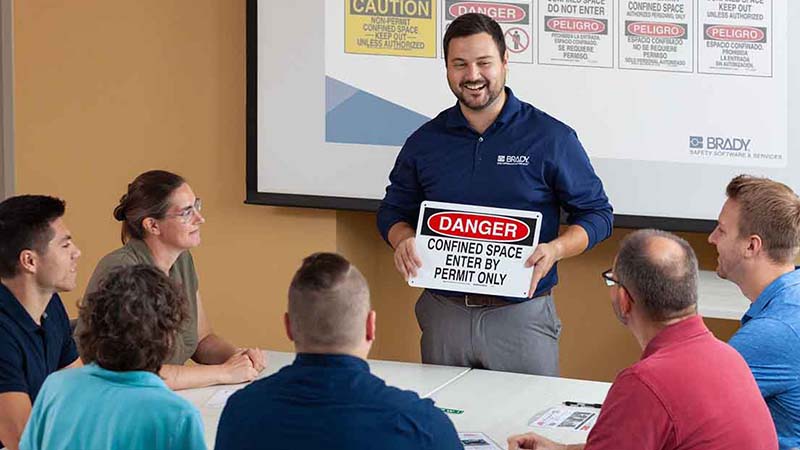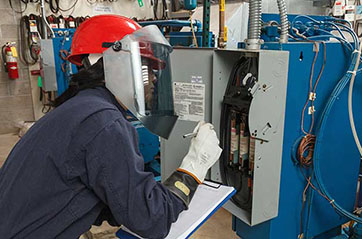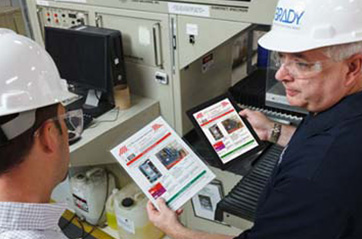Labels for Safety, Visuals and Facility ID Desktop Printers
Labels for Product, Wire and Lab ID Benchtop Printers
Labels for Safety, Visuals and Facility ID Desktop Printers
Labels for Product, Wire and Lab ID Benchtop Printers
Safety and Facility ID Desktop Printers
Product, Wire and Lab ID Benchtop Printers
Barcode Scanners and RFID Readers
PaintStripe Floor Marking Stencils
Valve Lockouts & Hose Lockouts
Group Lock Boxes & Permit Control
Pipe Marker Accessories & Mounting Brackets
Maintenance and Production Tags
Calculators and Assessment Tools
Product Finders and Data Sheets
No business can be truly successful without regular, well-planned training. From onboarding to introducing systems to refreshing important policies and procedures, training is essential. It's necessary to enhance the skills and knowledge of your workforce and drive your business forward.
A study published in the American Journal of Industrial Medicine found that regular training can result in behavioral change and enhanced organizational performance. Training and refresher programs positively improved safety compliance, increased awareness and use of protective equipment, and encouraged more effective communication.
By investing in training, businesses can expect tangible improvements. This article dives into some key benefits and best practices for annual refresher training.

Employee refresher training is about updating and reinforcing the knowledge and skills employees already have. It helps them stay sharp in their roles and keep up with the latest developments in their field. It also ensures their continued effective contribution to the organization's success and their careers.
In particular, refresher training is important for accomplishing the following objectives:
Employee onboarding and introductory training typically receive a lot of attention within organizations, and for good reason. But refresher training serves an equally important purpose for ongoing success.
Refresher training covers a broad spectrum of topics that will vary across organizations. However, a few central themes typically include reinforcing workplace efficiency, promoting a learning culture, customer service and more. Additionally, refresher training should focus on safety issues that might arise in the work environment.
According to the National Safety Council, some of the most common causes of workplace accidents include overexertion, slips and falls, and contact with objects or equipment. Refresher training on these topics could reduce the chance of injuries or serious accidents.
Workplace safety must be a top priority in any organization. Safety training is an investment that pays off through reduced injuries, improved productivity and a positive work environment. It’s crucial to cover the following key topics comprehensively in training:
Training topics such as these can go a long way to prevent accidents and keep businesses compliant with safety regulations.
The Occupational Safety and Health Administration (OSHA) has specific requirements and regulations to minimize workplace hazards. However, the rules can be complex and tend to change from time to time. That’s why OSHA compliance training is another important topic for refresher courses, and it should cover topics like:
Proper cleaning and maintenance procedures are crucial for aesthetics, hygiene and safety. Covering these topics in refresher training helps prevent accidents caused by unclean or poorly maintained equipment. Regular cleaning and maintenance also help identify dangers like loose wires, uneven floors or damaged machinery before they become a safety concern. Typical maintenance training topics include:
These aren't the only topics to be covered in maintenance training but are a good starting point.
With the rise of Industry 4.0 and other advanced technologies, cyber threats have become more concerning than ever. To mitigate cybersecurity risks, employees must have the knowledge and skills to use and maintain these tech tools. Training employees on security will help reduce the likelihood of a data breach.
This training should cover cybersecurity best practices like being cautious of suspicious links, using strong passwords, and regularly updating software and security systems. These simple steps can prevent cyberattacks from compromising sensitive company information or putting employees at risk.
Customer service refresher training allows employees to revisit and reinforce their understanding of essential customer service skills like:
Training can also include role-playing exercises and real-life scenarios to practice in a safe environment while building overall communication skills.
Clear communication is essential for everyone on a team to effectively execute their roles and understand potential hazards. This can lead to higher productivity and an enhanced culture of workplace safety. Good communication also helps employees feel better by improving confidence and strengthening team relationships.
Here are a few exercises to improve team cohesion, enhance communication skills, and foster understanding among team members:
When a team is in alignment and able to communicate well, it encourages employees to contribute ideas and feel empowered to share in the organization's success.
For refresher training to be effective, you must develop a well-designed and impactful course. This means covering relevant topics, using interactive elements and providing opportunities for employees to apply their knowledge. Here are a few basic tips to help get you started:
With a strong course and engaging refresher training methods, it's a win-win situation – employees can build their skills and confidence, while the organization benefits from improved safety and elevated performance.

A thorough, accurate arc flash risk assessment ensures worker safety and can save your company money.
Ensure electrical safety and compliance
How to create a sustainable LOTO program that keeps your workers safe.
Implement a strong LOTO program
Confined space compliance can feel overwhelming. Take these 5 actions now to enhance your safety program.
Improve your confined space compliance program